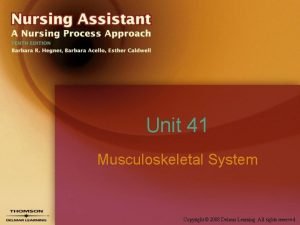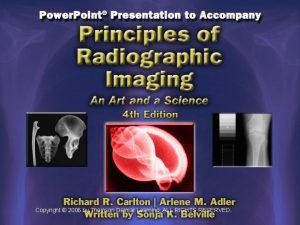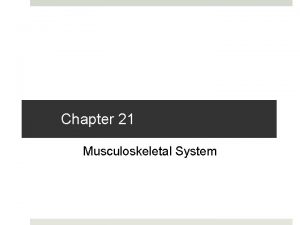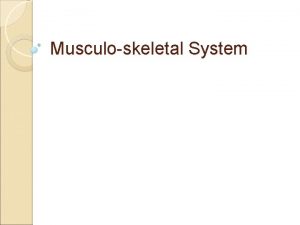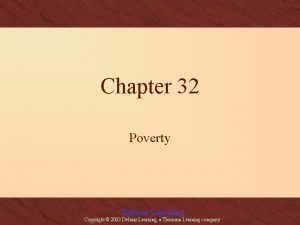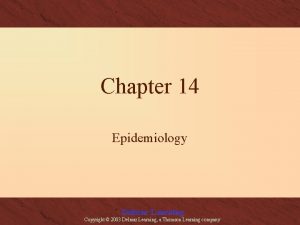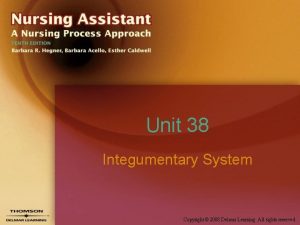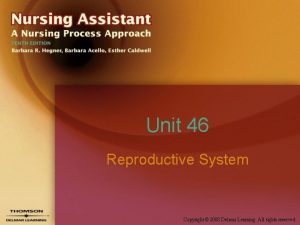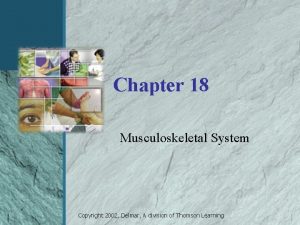Unit 41 Musculoskeletal System Copyright 2008 Delmar Learning










- Slides: 10

Unit 41 Musculoskeletal System Copyright © 2008 Delmar Learning. All rights reserved.

Objectives • Spell and define terms. • Describe the location and functions of the musculoskeletal system. • Describe some common conditions of the musculoskeletal system. Copyright © 2008 Delmar Learning. All rights reserved.

Objectives • Describe the nursing assistant actions related to the care of patients with conditions and diseases of the musculoskeletal system. • List seven specific diagnostic tests for musculoskeletal conditions. Copyright © 2008 Delmar Learning. All rights reserved.

The Musculoskeletal System • Skeleton – Bony frame of the body • Muscles – Tissues made up of contractile fibers or cells that produce movement – Together, the skeleton and muscles are termed the musculoskeletal system Copyright © 2008 Delmar Learning. All rights reserved.

Structure and Function • Review the parts of the human skeleton Copyright © 2008 Delmar Learning. All rights reserved.

Structure and Function • Review the major muscles of the body Copyright © 2008 Delmar Learning. All rights reserved.

Common Conditions • Many conditions can affect the bones, muscles, tendons, ligaments, and joints • Often, when one of these structures is diseased or injured: – Surrounding tissues are also involved Copyright © 2008 Delmar Learning. All rights reserved.

Range of Motion • Patients who have been ill or confined to bed are not as active as usual – Their joints may not move through the normal range of motion daily • Atrophy – Weakness and muscle wasting from lack of use Copyright © 2008 Delmar Learning. All rights reserved.

Range of Motion • Over time – Muscles become rigid – Joints do not move as freely as they once did – Joint movement may be painful because the muscles have shortened from lack of use Copyright © 2008 Delmar Learning. All rights reserved.

Range of Motion • When the joint moves – Muscles stretch • This causes discomfort or pain – As a result the patient may move even less Copyright © 2008 Delmar Learning. All rights reserved.
 Unit 41 musculoskeletal system
Unit 41 musculoskeletal system Delmar cengage learning medical terminology
Delmar cengage learning medical terminology 2009 delmar cengage learning
2009 delmar cengage learning 2009 delmar cengage learning
2009 delmar cengage learning Measuring and recording apical pulse
Measuring and recording apical pulse Delmar thomson learning
Delmar thomson learning Chapter 6 skeletal system
Chapter 6 skeletal system Chapter 13 medical math assignment sheet cengage learning
Chapter 13 medical math assignment sheet cengage learning Chapter 10 cultural diversity
Chapter 10 cultural diversity Delmar cengage learning instructor resources
Delmar cengage learning instructor resources 2008 2008
2008 2008
